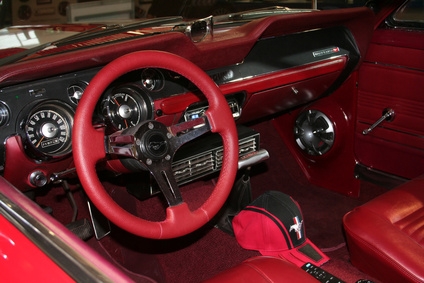
Muscle cars represented a time in American automotive manufacturing where vehicles where designed to look good and drive fast. Many muscle cars featured upgraded performance components while also adding the physical appearance of "sharp lines, wide profiles, muscular looks and chrome," according to "Timeless Rides." Muscle cars typically have V8 engines and were produced between 1965 ad 1973. However, the OPEC oil embargo and a tightening of regulations on the automotive industry by government regulations effectively ended the muscle car era. Nevertherless, muscle cars are highly sought as collectors items today. Improving the fuel efficiency of a muscle car can help to enjoy and prolong your driving experience.
Refit a different gear box. Muscle cars were fitted with a gear box that allowed for a lower gear ratio, allowing users to achieve a quick acceleration. However, as a result of the quicker acceleration, the car also burned through more gas than a slow and smooth acceleration. Installing a different gearbox, with a higher gear ratio will help to reduce fuel consumption while offering an increase in top-speed capabilities, since the car could move faster at a given RPM. Fewer RPMs generally mean less wear and tear on the engine as well as a greater fuel economy.
Purchase high octane gasoline at the pump. According to USMuscleMods, there are a couple of tricks to consider for your muscle car's fuel system. One consideration is to purchase premium gasoline at the pump. Another option is to include a fuel additive, such as an octane booster, which will help with gas mileage and overall horsepower. Fuel additives are available at most gas stations and auto-parts stores.
Install specialized performance computer chips. Computer chips are able to adjust the engine's fuel economy by increasing the efficiency of the engine control unit. These after-market modifications are available through auto-parts stores, but are recommended to be installed by professional mechanics. ECU computer chips such as these often cost several hundreds of dollars.
Change your driving habits. Instead of speeding up quickly, accelerate slowly, keeping the engine under 3,500 RPMs. Rarely, if ever, drive your car faster than 60 miles per hour (mph). According to the US Energy Department, studies have shown that fuel economy begins to drop dramatically whenever an automobile has a highway speed over 60 mph. Every 5 mph over 60 mph is equal to paying an extra quarter per gallon of gasoline. Coast down hills and towards stop signs and lights by putting the car in neutral. Coasting towards a stop will also help to save wear and tear on your brakes.
Install performance upgrades to your vehicle. A performance air filter or intake system will allow your engine to pull in air more easily. High-flow air filters can increase power and throttle response while also saving maintenance costs as they are washable and re-useable. Performance exhaust systems offer larger-diameter exhausts will also increase your gas mileage.